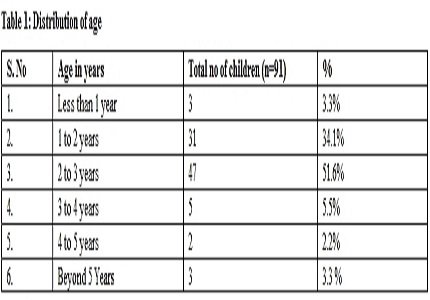Analysis of profile of childhood kerosene poisoning in a tertiary care medical college hospital
Abstract
Background: Children are very vulnerable to acute accidental poisoning. One of the most important poisoning in children is accidental ingestion of kerosene which is a common household substance. Its prevention plays a major role in reducing its morbidity and mortality in children.
Objective: To understand the profile of accidental kerosene poisoning in children with special reference to symptoms, complications, radiological changes, course and outcome after treatment.
Materials and Methods: Children hospitalized with acute poisoning at the paediatric intensive care unit (PICU) between January 1st 2010 and December 31st 2015 were retrospectively evaluated from hospital records. A detailed history was taken using the proforma having special reference to age, sex, poisoning agents and route of intake ,time of admission of the poisoned patients,socio- economic status of the family and cases with acute kerosene poisoning (AKP) were analysed.
Results: In the PICU out of a total of 5806 patients admitted, 401 (6.9%) were due to acute poisoning . Among them AKP was noted in 91 (22.7%) patients and was second only to pharmaceutical medicine poisoning in 128 (28.7%) cases. All the children were admitted to the PICU, but most only required supportive care. There was no mortality following AKP during the study period.
Conclusion: All paediatric age groups are at risk of AKP. Most children suffer due to unintentional poisoning because of easy availability of kerosene in their house itself. As AKP is preventable it must be given due importance in health control programs at all levels of health care.
Downloads
References
2. Hyder AA, Wali S, Fishman S, Schenk E. The burden of unintentional injuries among the under-five population in South Asia. Acta Paediatr. 2008 Mar;97(3):267-75. doi: 10.1111/j.1651-2227.2008.00670.x.
3. Bronstein AC, Spyker DA, Cantilena LR Jr, Green JL, Rumack BH, Heard SE; American Association of Poison Control Centers. 2007 Annual Report of the American Association of Poison Control Centers' National Poison Data System (NPDS): 25th Annual Report. Clin Toxicol (Phila). 2008 Dec;46(10):927-1057. doi: 10.1080/15563650802559632.
4. Lifshitz M, Sofer S, Gorodischer R. Hydrocarbon poisoning in children: a 5-year retrospective study. Wilderness Environ Med. 2003 Summer;14(2):78-82. [PubMed]
5. Singh S, Singhi S, Sood NK, Kumar L, Walia BN. Changing pattern of childhood poisoning (1970-1989): experience of a large north Indian hospital. Indian Pediatr. 1995 Mar;32(3):331-6. [PubMed]
6. Izuora GI, Adeoye A. A seven-year review of accidental poisoning in children at a Military Hospital in Hafr Al Batin, Saudi Arabia. Ann Saudi Med. 2001 Jan-Mar;21(1-2):13-5. [PubMed]
7. Abula T, Wondmikun Y. The pattern of acute poisoning in a teaching hospital, north-west Ethiopia. Ethiop Med J. 2006 Apr;44(2):183-9. [PubMed]
8. Paudyal BP. Poisoning : pattern and profile of admitted cases in a hospital in central Nepal. JNMA J Nepal Med Assoc. 2005 Jul-Sep;44(159):92-6. [PubMed]
9. Binetti R, Costamagna FM, Marcello I. Exponential growth of new chemicals and evolution of information relevant to risk control. Ann Ist Super Sanita. 2008;44(1):13-5. [PubMed]
10. GERARDE HW. Toxicologiccal studies on hydrocarbons. IX. The aspiration hazard and toxicity of hydrocarbons and hydrocarbon mixtures. Arch Environ Health. 1963 Mar;6:329-41. [PubMed]
11. Wasserman GS. Hydrocarbon poisoning. Grit Care Q 1982;4: 33-41. [PubMed]
12. Simmank K, Wagstaff L, Sullivan K, Filteau S, Tomkins A. Prediction of illness severity and outcome of children symptomatic following kerosene ingestion. Ann Trop Paediatr. 1998 Dec;18(4):309-14. [PubMed]
13. Wolfe BM, Brodeur AE, Shields JB. The role of gastrointestinal absorption of kerosene in producing pneumonitis in dogs. J Pediatr. 1970 Jun;76(6):867-73. [PubMed]
14. Arena JM. Hydrocarbon poisoning--current management. Pediatr Ann. 1987 Nov;16(11):879-83. [PubMed]
15. Klein BL, Simon JE. Hydrocarbon poisonings. Pediatr Clin North Am. 1986 Apr;33(2):411-9. [PubMed]
16. Nagi NA, Abdulallah ZA. Kerosene poisoning in children in Iraq. Postgrad Med J. 1995 Jul;71(837):419-22. [PubMed]
17. Munro SA, van Niekerk A, Seedat M. Childhood unintentional injuries: the perceived impact of the environment, lack of supervision and child characteristics. Child Care Health Dev. 2006 May;32(3):269-79. [PubMed]
18. Akamaguna AI, Odita JC. Radiology of kerosene poisoning in young children. Ann Trop Paediatr. 1983 Jun;3(2):85-8. [PubMed]
19. Schwebel DC, Swart D, Simpson J, Hobe P, Hui SK. An intervention to reduce kerosene-related burns and poisonings in low-income South African communities. Health Psychol. 2009 Jul;28(4):493-500. doi: 10.1037/a0014531. [PubMed]
20. Abu-Ekteish F. Kerosene poisoning in children: a report from northern Jordan. Trop Doct. 2002 Jan;32(1):27-9. [PubMed]
21. Ellis JB, Krug A, Robertson J, Hay IT, MacIntyre U. Paraffin ingestion--the problem. S Afr Med J. 1994 Nov;84(11):727-30. [PubMed]
22. Fagbule DO, Joiner KT. Kerosene poisoning in childhood: a 6-year prospective study at the University of Ilorin Teaching Hospital. West Afr J Med. 1992 Apr-Jun;11(2):116-21. [PubMed]
23. de Wet B, van Schalkwyk D, van der Spuy J, du Plessis J, du Toit N, Burns D. Paraffin (kerosene) poisoning in childhood--is prevention affordable in South Africa? S Afr Med J. 1994 Nov;84(11):735-8. [PubMed]
24. Khan NU, Fayyaz J, Khan UR, Feroze A. Importance of clinical toxicology teaching and its impact in improving knowledge: sharing experience from a workshop. J Pak Med Assoc. 2013 Nov;63(11):1379-82. [PubMed]
25. Shotar AM. Kerosene poisoning in childhood: a 6-year prospective study at the Princess Rahmat Teaching Hospital. Neuro Endocrinol Lett. 2005 Dec;26(6):835-8.

Copyright (c) 2016 Author (s). Published by Siddharth Health Research and Social Welfare Society

This work is licensed under a Creative Commons Attribution 4.0 International License.


 OAI - Open Archives Initiative
OAI - Open Archives Initiative


